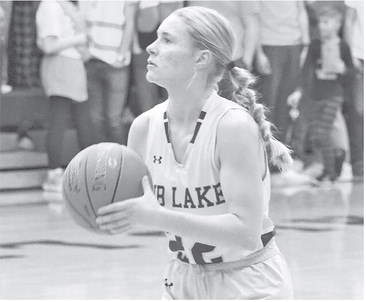CDAC sticks with initial quotas, harvest authorizations
With time on its hands last month, the general public jumped at the chance to complete surveys on the Wisconsin Department of Natural Resources website in response to preliminary recommendations for the 2020 deer hunting season made April 6 by Taylor County’s Deer Advisory Council.
But after viewing results from the recordsmashing 482 completed surveys, which included a record 119 written comments, the council on Monday night stuck with its initial antlerless harvest quotas and permit numbers while finalizing its recommendations for this fall.
The council is submitting harvest quotas of 2,500 antlerless deer on the county’s private lands and 300 antlerless deer on public lands. The council kept its projected 30% success rate, translating in 8,350 bonus harvest authorizations being made available to private-land hunters and 1,000 for publicland hunters.
In 2019, the quotas were 2,100 and 250 respectively, with 5,600 and 675 permits being sold.
The final recommendations will be reviewed by the DNR this month and go to the Natural Resources Board for final approval during its June 23-24 meeting.
Meeting via teleconference, the council started Monday’s discussion by reviewing the public feedback it received during a twoweek period in April. The key questions on the survey asked for respondents’ opinions on the preliminary quotas and permit numbers.
The recommended quota was viewed as “about right” by 174 people, “too high” by 133, “much too high” by 88, “too low” by 49 people and “much too low” by 29. Nine were unsure.
The private-land permit number of 8,350 drew responses of “about right” by 178 people, “too high” by 137 people, “much too high” by 97, “too low” by 36 and “much too low” by 20. Fourteen were unsure. The public- land tag number of 1,000 drew responses of “about right” by 166 people, “too high” by 111 people, “much too high” by 105, “too low” by 55 and “much too low” by 28. Seventeen were unsure.
While hunt/conservation club representative Chip Courtney and DMAP representative Brian Bucki expressed early concern that the “too highs” and “much too highs” significantly outnumbered the “too lows” and “much too lows,” chairman Mike Riggle pointed out the “about rights” were still the most common responses.
“What sticks out to me when you look at the feedback and where are people on our 2020 recommendations, you’re in the middle,” he said. “I always figure on this thing you want to be in the middle. You want about half the people saying you’re doing too much and half the people saying you’re doing too little or about right. We’re in the middle. We’re on the side I think we need to be on.”
DNR wildlife biologist Josh Spiegel noted he went through the 119 written comments and found only 28 actually focused on the proposed quotas and permit levels. The rest featured more anecdotal information, which is taken to account, but isn’t the true intent of the survey.
“Fifteen people thought it should be zero quota or decreased from its current stage and 13 thought it should be maintained or increased, so pretty close to 50-50,” he said.
From there, the discussion went back to the preliminary recommendations and how members viewed them four weeks later.
Courtney and Bucki and alternate chair Tracy Swedlund initially showed interest in decreasing the public-land numbers slightly, forestry representative Jake Walcisak favored increasing the numbers on both land types, transportation representative Scott Mildbrand felt a slight uptick on private-land numbers would work and tourism representative Clint Sackman still felt the preliminary numbers were “pretty darn accurate.”
The first vote of the night asked if council members favored increasing private-land quota numbers, which Walcisak and Mildbrand did, but their votes were outnumbered 4-2.
The next vote asked if council members favored decreasing the public-land permit numbers, which Courtney, Bucki and Swedlund did, but the rest did not, forcing a 3-3 tie. Riggle broke the tie by voting no.
Those votes drew an interesting counterpoint from Walcisak.
“There are more respondents who said too high or much too high for private than what there was for public and then the flip side of that is there are more respondents who said too low or much too low for public than there were for private authorizations,” he said. “So while we’re here considering currently what sounds like what could have been potentially more tags on private and could have been potentially less tags on public, I would say the responses are reverse of that when we look at too high, much too high, too low and much too low.” Before the final vote, Spiegel reminded the council the DNR’s data suggests that despite the proposed increases in the quotas and permit numbers, the county’s deer population should continue to rise this year and it could be steep based on two factors. One was the county’s harvest last year was well under projections, which means about 1,000 of the deer the council thought were going to be killed are theoretically still on the landscape. The other is the mild winter that just ended and the higher probability for a large fawn crop that will start showing up soon.
Spiegel said DNR statistics indicate a 9% population increase this year with the proposed quota and permit numbers.
“My concern moving forward is we have to be able to take little bites every year,” he said. “We can’t let the deer population climb too fast because looking into the crystal ball, if you will, if you have to look four to five years down the road, a 9% increase could be very large in a swing. I would be in more favor of taking a few more private land deer this year and maybe even into the future. If we raise that quota, 200 deer countywide, that comes out to basically one-third of a deer for every square mile of private land and so you’re talking about taking one more deer for every three square miles.”
Riggle and Spiegel emphasized an advantage Taylor County has is that private-land figures are quite flexible. If the council and the public feels a few too many deer are harvested in one year, adjustments can be easily made the next year. That’s much tougher to do on public land.
“It’s really tough as a CDAC right now looking at some, what I’ll call, accurate data,” Bucki said. “It’s a tough one. I guess what I need is some black-andwhite data in front of my face to show me this big increase that took place because I think the majority of the people think we’re about the same as we were last year as far as the population of deer in this county.”
“What the model is saying is that we’re projecting an increase with our recruitment,” Spiegel said. “Basically we’re going to have more productive deer on the landscape. We won’t see it right now. We’re going to see it by this hunting season.”
Mildbrand said his reasoning for proposing a few more private-land permits is to head off any future discussions of Earn-A-Buck or massive permit numbers.
Riggle called for a confirming vote to keep the recommendations as they were in April. It passed 4-2 with Walcisak and Mildbrand dissenting.
Looking ahead, council members said what they’ll be most interested to watch regarding the 2020 season are how the 8,350 private-land tags will sell and the hunters’ success rates in filling those tags. Last year’s 5,600 private-land tags sold in a month’s time with the last ones going on Sept. 19.
Success rates, which in the early 2000s were typically around 40% and were 39% as recently as 2016, fell to 34.2% and 33.6% overall in Taylor County in 2017 and 2018 and just 28.5% on private land and 25% on public land during a 2019 season affected by two major snowstorms in the season’s last five days.
“One thing that we will always see as the tags increase is that success rate will drop,” Spiegel said. “It might not be much, but it hardly ever goes up with the exception of this year, because we know it was a poor hunting season. We could see it settle somewhere around that 33%, maybe 32% something like that.”
“I don’t think it has anything to do with weather or anything else,” Riggle said. “I think it has to do with the fact, people don’t kill as many deer anymore. Me personally, our family used to kill five, six deer a year. Now if we kill three, that’s probably enough. We don’t need to shoot any more does. I hear that from a lot of other people. I think it’s more a societal thing more than anything else.”
“It will be interesting to see this year if we can actually sell that amount of tags,” Bucki said. “Hopefully we do and I agree on the private land that there’s some deer out there to be shot. I think that will be one thing that will be interesting to watch to see if we can actually sell that many tags.”




